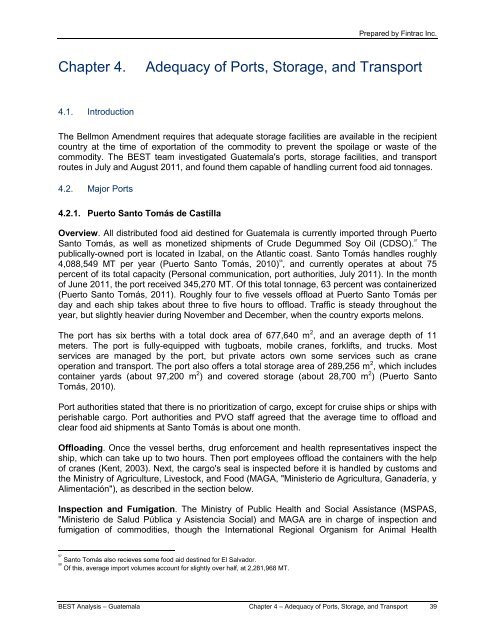usaid office of food for peace guatemala bellmon estimation
usaid office of food for peace guatemala bellmon estimation
usaid office of food for peace guatemala bellmon estimation
You also want an ePaper? Increase the reach of your titles
YUMPU automatically turns print PDFs into web optimized ePapers that Google loves.
Prepared by Fintrac Inc.<br />
Chapter 4. Adequacy <strong>of</strong> Ports, Storage, and Transport<br />
4.1. Introduction<br />
The Bellmon Amendment requires that adequate storage facilities are available in the recipient<br />
country at the time <strong>of</strong> exportation <strong>of</strong> the commodity to prevent the spoilage or waste <strong>of</strong> the<br />
commodity. The BEST team investigated Guatemala's ports, storage facilities, and transport<br />
routes in July and August 2011, and found them capable <strong>of</strong> handling current <strong>food</strong> aid tonnages.<br />
4.2. Major Ports<br />
4.2.1. Puerto Santo Tomás de Castilla<br />
Overview. All distributed <strong>food</strong> aid destined <strong>for</strong> Guatemala is currently imported through Puerto<br />
Santo Tomás, as well as monetized shipments <strong>of</strong> Crude Degummed Soy Oil (CDSO). 57<br />
The<br />
publically-owned port is located in Izabal, on the Atlantic coast. Santo Tomás handles roughly<br />
4,088,549 MT per year (Puerto Santo Tomás, 2010) 58<br />
, and currently operates at about 75<br />
percent <strong>of</strong> its total capacity (Personal communication, port authorities, July 2011). In the month<br />
<strong>of</strong> June 2011, the port received 345,270 MT. Of this total tonnage, 63 percent was containerized<br />
(Puerto Santo Tomás, 2011). Roughly four to five vessels <strong>of</strong>fload at Puerto Santo Tomás per<br />
day and each ship takes about three to five hours to <strong>of</strong>fload. Traffic is steady throughout the<br />
year, but slightly heavier during November and December, when the country exports melons.<br />
The port has six berths with a total dock area <strong>of</strong> 677,640 m 2 , and an average depth <strong>of</strong> 11<br />
meters. The port is fully-equipped with tugboats, mobile cranes, <strong>for</strong>klifts, and trucks. Most<br />
services are managed by the port, but private actors own some services such as crane<br />
operation and transport. The port also <strong>of</strong>fers a total storage area <strong>of</strong> 289,256 m 2 , which includes<br />
container yards (about 97,200 m 2 ) and covered storage (about 28,700 m 2 ) (Puerto Santo<br />
Tomás, 2010).<br />
Port authorities stated that there is no prioritization <strong>of</strong> cargo, except <strong>for</strong> cruise ships or ships with<br />
perishable cargo. Port authorities and PVO staff agreed that the average time to <strong>of</strong>fload and<br />
clear <strong>food</strong> aid shipments at Santo Tomás is about one month.<br />
Offloading. Once the vessel berths, drug en<strong>for</strong>cement and health representatives inspect the<br />
ship, which can take up to two hours. Then port employees <strong>of</strong>fload the containers with the help<br />
<strong>of</strong> cranes (Kent, 2003). Next, the cargo's seal is inspected be<strong>for</strong>e it is handled by customs and<br />
the Ministry <strong>of</strong> Agriculture, Livestock, and Food (MAGA, "Ministerio de Agricultura, Ganadería, y<br />
Alimentación"), as described in the section below.<br />
Inspection and Fumigation. The Ministry <strong>of</strong> Public Health and Social Assistance (MSPAS,<br />
"Ministerio de Salud Pública y Asistencia Social) and MAGA are in charge <strong>of</strong> inspection and<br />
fumigation <strong>of</strong> commodities, though the International Regional Organism <strong>for</strong> Animal Health<br />
57<br />
Santo Tomás also recieves some <strong>food</strong> aid destined <strong>for</strong> El Salvador.<br />
58<br />
Of this, average import volumes account <strong>for</strong> slightly over half, at 2,281,968 MT.<br />
BEST Analysis – Guatemala Chapter 4 – Adequacy <strong>of</strong> Ports, Storage, and Transport 39

















